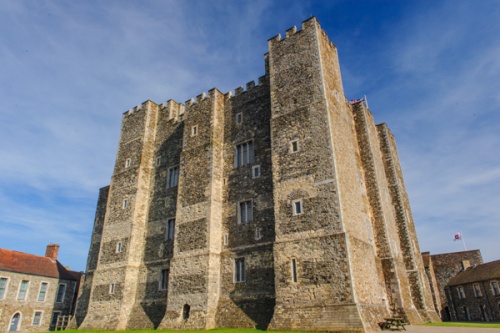
Dover Castle was begun in 1066 but is largely a product of Henry II's expansion in 1170. In the 13th century, King John ordered the building of underground tunnels connected to sally ports in order to surprise attacking troops. These tunnels were later used as a military command centre during WWII (see the extensive reconstructions). Within the castle grounds stand a Roman lighthouse and a Saxon church.
History
'The Key to the Kingdom'
This imposing castle towers - quite literally - over the historic port of Dover, at the western end of the iconic White Cliffs. The Iron Age inhabitants of the area we now call Kent recognised the strategic importance of the hill, and built a fort here over 2000 years ago.
The Romans, in turn, built a pharos, or lighthouse, inside the hill fort, and a matching lighthouse atop the Western Heights, across Dover harbour. The second lighthouse is gone now, but the first one still stands atop the hill looking across to France, 21 miles away.
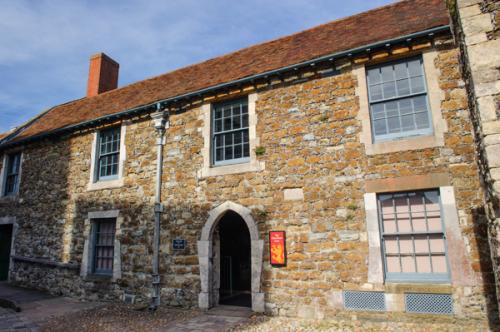
Long after the Romans left in AD 410 a Saxon burgh, or fortified town, flourished within the earthwork defences. Around AD 1000 the Saxons erected a church beside the Roman lighthouse. The church of St Mary in Castro still stands, though much remodelled in the Victorian period.
According to legend, King Harold, the last Saxon king of England, promised to give Dover 'castle' to William the Conqueror. It seems doubtful that there was anything resembling an actual castle at that time, and Harold may simply have meant the fortified hilltop and Iron Age defences.
William marched through Dover following his success at the Battle of Hastings in 1066, and built a ringwork defensive wall, much of which is obliterated by later construction. Sometime in the century following the Norman invasion the town of Dover moved from the hilltop to the low-lying land by the harbour.
Whether this move was voluntary or enforced by the Normans we simply don't know, but when Henry II decided to create his magnificent new stone castle here in 1080 the hilltop site was largely empty aside from the church and lighthouse. Henry built a huge stone keep, protected by a ringwork inner curtain wall to the north-west of the original ringwork.
We know from the Royal Pipe Rolls, or financial records, that from 1080-1090 the crown spent 6300 pounds building Dover Castle. For the time this was an eye-watering amount of money, and underlines just how imposing and impressive Henry meant his new fortress to be.
Unusually for the period, we even know the name of the builder; the king's Master Mason, one Maurice the Engineer, who had just completed the castle keep at Newcastle-upon-Tyne.
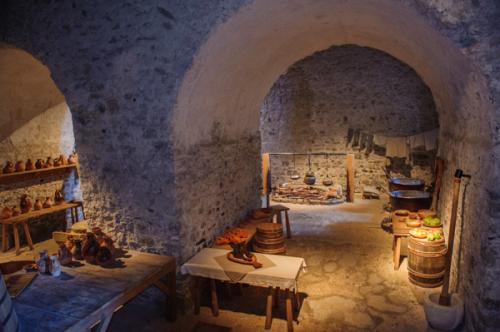
King John extended Henry II's outer curtain wall, starting work in 1207 after he had lost control of Normandy. He must have sensed a threat from France, and he was right, though not perhaps in quite the way he might have thought. For John's rebellious barons invited Louis, Dauphin of France, to become king of England.
Louis besieged Dover in 1216, digging a mine under John's gatehouse. The Constable, Hubert de Burgh, hurriedly placed timber in the breach and managed to hold off the attackers long enough for fate to take a hand.
And fate did indeed take a hand, for John conveniently died, Louis' bid for the throne faltered, and Dover was saved. The tower was rebuilt, but the gateway blocked permanently.
One of the most impressive remaining towers is Constable's Gate, so-called because it served as the official residence for the Constable after that officer moved from the first floor of the keep.
Though the curtain wall and towers might have been enough to defend Dover, the medieval engineers were not done. They built a series of underground tunnels, connecting the castle with the earthwork beyond the north curtain wall.
These tunnels, though enlarged and extended in the Napoleonic Wars, still exist in their original form. Using the tunnels, the castle garrison would have been able to send a force of men under the curtain and attack a besieging enemy from the rear.
The castle was under attack again in 1263, when Henry III's barons, led by Simon de Montfort, rebelled. De Montfort seized Dover Castle in July of that year, and in May 1264 Prince Edward (the future Edward I) was held prisoner here. De Montfort's wife, Eleanor, held the castle briefly, but when the rebel cause ended with defeat at Evesham in 1265 she was forced to surrender.
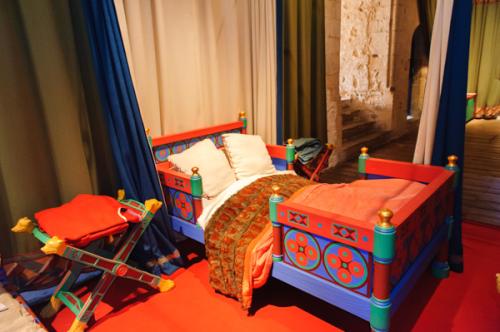
The Post-Medieval Period
Edward IV renovated Dover Castle to serve as an occasional royal residence, inserting fine new windows and fireplaces. We don't know if Edward ever actually stayed here, but other royals certainly did; in 1520 Emperor Charles V stayed in the castle, and Henry VIII stopped here on his way to the Field of the Cloth of Gold.
Henry's daughter, Elizabeth I visited, but by the time Henrietta Maria of France stayed on her way to marry Charles I, it was described as 'an old building in the antique manner'.
George de Villiers, 1st Duke of Buckingham, embarked on a lavish renovation of the Great Tower, but much of his rebuilding has been lost to time.
The castle was briefly held by Royalist troops during the Civil War, but Parliamentary supporters from the town staged a daring raid, scaling the cliffs at night and taking the garrison by surprise.
Dover escaped the slighting that Parliament meted out to so many other fortresses, but it could not escape the ravages of time; in the late 17th century the Great Tower was stripped of its creature comforts and used to house French prisoners of war. Graffiti carved into the walls by the prisoners can still be seen in places.
During the mid-18th century the defences were upgraded to counter the threat of invasion following the War of Austrian Succession (begun 1740) and the Seven Years War (1756). But the threat of invasion was far greater in the Napoleonic Wars (1793-1815) and this period saw the greatest rebuilding at Dover since the 13th century.
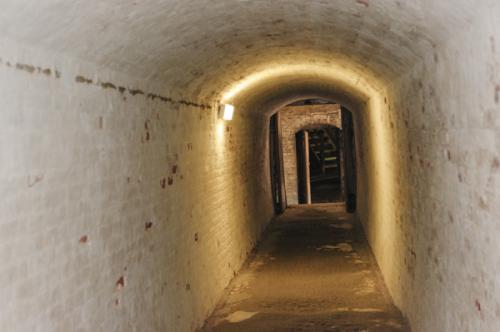
Much of the work was supervised by Lieutenant-Colonel William Twiss, a military engineer of outstanding ability, who built new barracks and casements, and rebuilt the walls to withstand modern artillery fire.
More impressively perhaps, Twiss built a complex of tunnels under the castle, extending to the very face of the White Cliffs. The last major building of the 19th century was the Officer's New Barracks, designed by Anthony Salvin (beside the current parking area).
The tunnels built by Twiss during the Napoleonic period were put to use during World War II, when they formed a naval operation centre and hospital. It was from here, far beneath ground level, that Vice-Admiral Bertrand Ramsay oversaw Operation Dynamo, the 'Miracle of Dunkirk' (more details below).
During the Cuban Missile Crisis of 1962, when it seemed the world might be on the brink of a nuclear war, a series of tunnels were equipped to serve as an emergency government headquarters. It was not until the 1980s that the 'nuclear' tunnels were decommissioned. Since then Dover Castle has been preserved for its historic interest and administered by English Heritage.
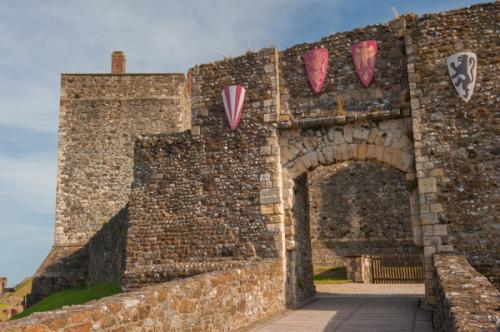
What to See
Arthur's Hall
Within the inner curtain, facing the Great Tower forebuilding is this great hall, the social hub of castle life, probably built for Henry III around 1236. We do not know for certain why it is called Arthur's Hall; we can only speculate that the name was intended to honour King Arthur.
At the south-east end are three arched openings. The arches give access to the kitchens, buttery, and pantry. The hall was reroofed in the 1740s when a new floor was inserted.
Today the hall houses an exhibition on the history of the castle and the Plantagenet dynasty. Beside Arthur's Hall is the museum of the Princess of Wales Royal Regiment and the Queens Regiment.
The Medieval Tunnels
When Hubert de Burgh rebuilt the castle after the siege of 1216-17, he erected a series of outworks to the northwest of the Norfolk Towers. The new defences included the cylindrical tower of St John, in the outer ditch, and a triangular outer spur, or bastion.
From the air these early 13th century defences look like a pointed arrow projecting from the castle walls. But not all of Hubert de Burgh's work is visible above ground, for he linked his new defences to the main castle by a series of tunnels.
One shaft led beneath the Norfolk Gates to St John's Tower, where a drawbridge gave access to another tunnel under the spur. Sally ports (small side gates) gave access to the ditch. Much of the medieval tunnel system still exists, and is reached from a stair between the King's Gate and the Norfolk Gates.
The tunnels were extended and strengthened in 1756 and again in the Napoleonic War period, but they are essentially as they would have looked when they were finished in 1221, and represent an extraordinary feat of medieval engineering.
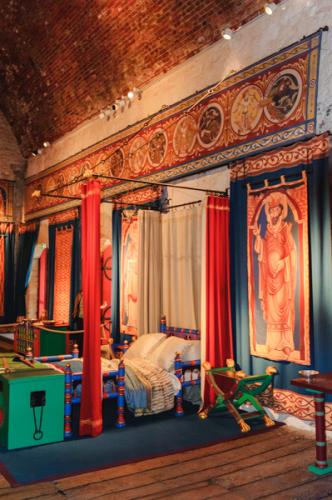
The Great Tower
The showpiece of Dover, the great stone keep erected by Maurice the Engineer for Henry II is a huge cube, measuring 100 feet in each direction, with imposing corner turrets and an elaborate L-shaped forebuilding with a further three projecting turrets.
The forebuilding acts as a grand staircase, giving access, not to the first floor, as you might expect, but to the second floor, where the royal hall and solar (private apartments) are located.
The forebuilding was originally roofless, so any attackers getting inside would be subjected to a rain of missiles thrown from the tower parapets above. At the point where the forebuilding stair changes direction there is a small, rather ornately carved chapel, perhaps erected as a place for more welcome guests to give thanks for a successful journey upon arrival.
The hall level is double-height, with a gallery running around the exterior and several small, private chambers in the thickness of the walls.
In one of these chambers is one of the most amazing - and uncelebrated - examples of medieval engineering anywhere in Britain; a well shaft, which sinks down fully 350 feet into the chalk beneath to reach water. To put that in perspective, the well shaft is as deep as the spire of Salisbury Cathedral is tall.
The main attraction in the tower, however, at least for most visitors, is that English Heritage has painstakingly recreated the look and feel of the authentic Norman castle, with bedchambers, furniture, and decoration that echo as precisely as possible what the rooms would have looked like.
The one exception to the authenticity of the decor is that there are painted wall-hangings, where the original scheme would have had the actual walls painted.
However, as one English Heritage room steward told me, they couldn't actually use paint on the walls in case they damaged the real medieval paint that still exists, so they did the next best thing. I must say that the result is staggering; every surface appears to glow with colour. It reminds me of nothing so much as a 1960s decoration scheme, with vivid, pure colours everywhere.
It is worth remembering that medieval buildings were generally highly decorated, not bare and cold stone as we so often see them today. So it is a real experience for the senses to see the rooms in the tower much as Henry II or his descendants might have seen them.
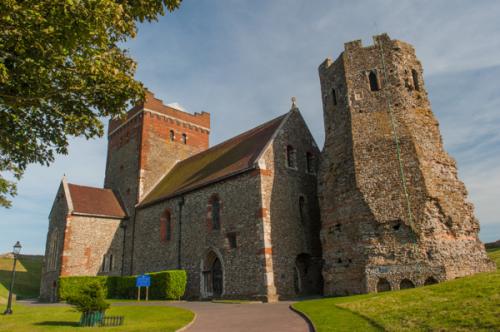
The tower is contained within an inner curtain wall with 14 mural towers. Two pairs of towers are placed close together to form the earliest twin-towered gateways in England; Palace Gate and King's Gate. Eighteenth-century barracks fill in much of the space within the inner curtain wall.
St Mary in Castro church
This delightful cruciform church stands at the highest point of Dover Castle, its bands of red brick and pale stone standing out like a beacon. Begun around 1000 AD, and heavily remodelled in the Victorian period, St Mary served as the church for the garrison of Dover Castle.
The size and layout of the building suggest that it was a minster, acting as a mother church for the region and served by a community of priests. Construction is of flint and ragstone rubble with Roman bricks reused in the quoins and around doors and window openings.
During the medieval period, sacred relics were kept in the church. The building was restored in 1582 but allowed to fall into decay in the 17th century.
By the 18th century, the building was little more than a crumbling shell. Used as a fives court and a coal store, the church was finally restored in 1862 by George Gilbert Scott. The final touches were applied by William Butterfield in 1888, and today the interior is typical of Butterfield's 'High Church' work, with polychrome decoration, a mosaic altar, and tiled floors.
Traditionally there were three different service times, with the rank and file attending the earliest service and higher ranks later in the day.
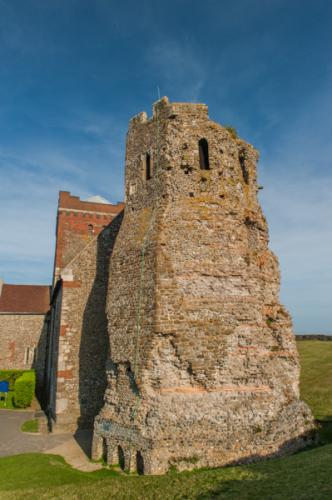
The Roman Lighthouse
Beside the church of St Mary stands the Roman pharos, erected to guide shipping along the coast and into Dover harbour sometime in the first half of the second century AD (i.e. roughly 125 AD).
The lighthouse is built to an octagonal plan, using ragstone and flint with brick dressings and brick archways. It is built with five tapering stages. The bottom four stages are original Roman work, while the top stage was added around 1430 by Humphrey, Duke of Gloucester, to act as a bell tower for St Mary in Castro church.
In the 1580s the lighthouse was reroofed and restored to act as a powder magazine. The structure is in remarkable condition, though obviously suffering the effects of weathering. You can go through an opening into the centre of the lighthouse, which is hollow.
Secret Wartime Tunnels
One of the most interesting - and most recent - attractions at Dover is the Secret Wartime Tunnels. These tunnels were begun during the Napoleonic Wars and greatly extended during World War II.
During that conflict they acted as the command centre for naval operations along the south coast, and it was from here that Vice-Admiral Bertrand Ramsay oversaw Operation Dynamo, the evacuation of British and Allied forces from Dunkirk.
Access to the tunnels is by guided tour only, and the tour takes about 45 minutes. It consists of a series of audio-visual experiences which tell the story of the Dunkirk rescue. At the end of the tour is a museum area, with more exhibits about the Dunkirk story and about the role played by people who worked in the tunnels during the war. There is a further tour available exploring a WWII hospital area, next to the Secret Wartime Tunnels.
From the tunnels, it is only a short walk to Admiral Ramsay's Lookout, which offers wonderful views across the Channel and east to the White Cliffs.
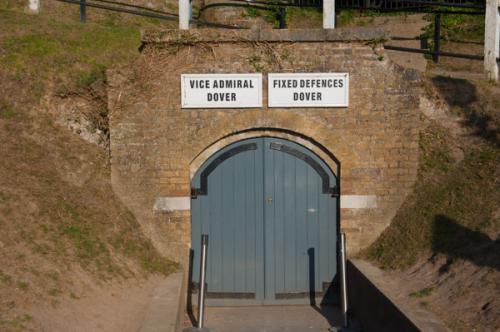
Visiting Dover Castle
I foolishly assumed that I could take my family around the castle in a couple of hours, and have plenty of time to see Dover itself, and pop down the coast to Deal and Walmer Castles. Oh, how wrong I was!
There is so much to see at Dover that I strongly, strongly advise you to leave at least 4 hours for a visit. If you have the time, allow 5-6 hours and take it slow and easy. There truly is so much to see that to do justice to it all you really need a minimum of a half day, and, depending on your interests, a lot more.
The wartime tunnels alone will take at least 45 minutes - more if you take your time over the museum at the end of the tour, and that's not counting the time you may have to stand in line if it is a busy time of year.
Something for everyone
Perhaps a personal anecdote best sums up visiting Dover Castle; when my family had finished our visit (our second in 4 days!) I asked everyone which part had been their favourite. We each chose something different. My daughter liked St Mary de Castro church, my son the medieval tunnels, my wife the Great Tower, and I was torn between the Wartime Tunnels and the Roman lighthouse!
- Henry II's Great Tower
- Roman Lighthouse
- Saxon church of St Mary in Castro
- Arthur's Hall
- Medieval Tunnels
- Secret Wartime Tunnels
About Dover Castle
Address: Castle Hill,
Dover,
Kent,
England, CT16 1HU
Attraction Type: Castle
Website: Dover Castle
English Heritage - see also: English Heritage memberships (official website)
Location
map
OS: TR325 419
Photo Credit: David Ross and Britain Express
HERITAGE
 We've 'tagged' this attraction information to help you find related historic attractions and learn more about major time periods mentioned.
We've 'tagged' this attraction information to help you find related historic attractions and learn more about major time periods mentioned.
Historic Time Periods:
Find other attractions tagged with:
13th century (Time Period) - 17th century (Time Period) - 18th century (Time Period) - 19th century (Time Period) - castle (Architecture) - Charles I (Person) - Civil War (Architecture) - Decorated (Architecture) - Edward I (Person) - Edward IV (Person) - Elizabeth I (Person) - Gilbert Scott (Person) - Henry II (Person) - Henry III (Person) - Henry VIII (Person) - hill fort (Historical Reference) - Iron Age (Architecture) - King Harold (Person) - King John (Person) - Medieval (Time Period) - Norman (Architecture) - Parliamentary (Historical Reference) - Roman (Time Period) - Royalist (Person) - Saxon (Time Period) - Victorian (Time Period) - William the Conqueror (Person) -
NEARBY HISTORIC ATTRACTIONS
Heritage Rated from 1- 5 (low to exceptional) on historic interest
Roman Painted House - 0.5 miles (Roman Site) ![]()
Dover Museum - 0.5 miles (Museum) ![]()
White Cliffs of Dover - 0.8 miles (Countryside) ![]()
Knights Templar Church - 1 miles (Historic Church) ![]()
Western Heights - 1 miles (Historic Building) ![]()
South Foreland Lighthouse - 2.4 miles (Historic Building) ![]()
Waldershare, All Saints Church - 4.3 miles (Historic Church) ![]()
Capel-le-Ferme, St Mary's Church - 4.4 miles (Historic Church) ![]()
Nearest Holiday Cottages to Dover Castle:
St Margarets-at-Cliffe, Kent
Sleeps: 22
Stay from: £3637 - 23755
St Margarets-at-Cliffe, Kent
Sleeps: 4
Stay from: £623 - 3127
More self catering near Dover Castle



